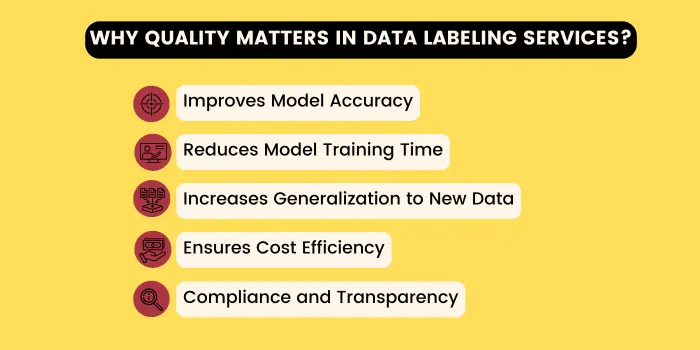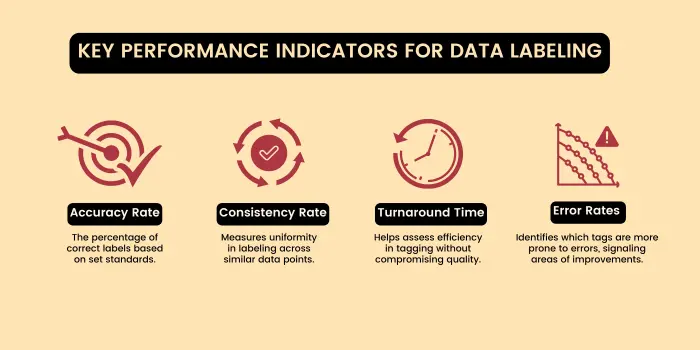Data tagging or labeling for AI is essential in training machine learning (ML) models. When you are training an ML model to recognize different types of fruit in photos, you’d start by giving the model a large set of images, each tagged with the correct label, like “apple,” “banana,” or “orange.” So, an image of a banana would have a tag that says “banana.”
By repeatedly “seeing” images labeled in this way, the model learns the unique visual characteristics of each fruit type—like color, shape, and texture. Later, when a new photo of a banana is shown, it can be identified based on the patterns learned from those tagged training images.
However, ensuring accurate data tagging for AI can be challenging, especially when working on a large scale. Here, we’ll cover strategies for accurate data tagging for AI, focusing on the value of outsourcing data labeling services, maintaining accuracy, and optimizing tagging workflows.
Accurate data tagging for AI is the backbone of ML training. The accuracy of an ML model is heavily influenced by how well the data has been labeled initially.
Here’s why it matters:

Guidelines set clear criteria for how each data point should be tagged. The more precise these guidelines, the easier it becomes for taggers to deliver consistent results. Creating effective tagging guidelines is essential for ensuring consistency and accuracy during data labeling services.
Here are some steps to help you establish comprehensive tagging guidelines:

Clearly outline the purpose of tagging for your project. Specify what you want the model to learn from the data and how it will be used in the future. For example, if you’re tagging images for an object detection model, your objective might be enabling the model to identify various objects in different contexts accurately.
Effective data tagging strategy requires clear categorization and well-defined tag meanings to ensure accuracy and consistency in labeling.
Use examples and counterexamples to help labelers apply tags correctly and consistently.
Set clear formatting and hierarchy rules to maintain consistency and make tagged data easily searchable and organized.
Implement a review and feedback system to ensure accuracy and consistency in data tagging strategies, with quality checks and clear communication for improvement.
As the project evolves or new types of data are introduced, revisit and update the guidelines. Collect feedback from labelers and stakeholders to refine the tagging process continuously.
Outsourcing data labeling services can provide access to trained professionals who specialize in tagging for ML training, often at a lower cost than maintaining an in-house team.
Reliable data labeling service providers offer scalable, flexible resources that can adapt to the scope and complexity of a project. When selecting a provider, consider factors like their experience in your industry, previous projects, and the quality standards they maintain.
Automation can powerfully improve tagging efficiency, especially for repetitive or simple labeling tasks. Using AI-based tools, certain tagging tasks can be performed automatically, reducing the workload for human taggers and minimizing manual errors.
A multi-step quality control process can drastically improve accuracy, as different reviewers can spot issues that might be missed in a single pass.
Implementing this layered approach creates a robust review system that reduces error rates and improves reliability.
Introducing KPIs can help you objectively measure quality across tagging tasks, enabling you to spot trends and address potential issues.

KPIs help you make data-driven decisions to enhance quality and efficiency over time.
Active learning is a technique that allows your ML models to “learn” from human feedback on complex or uncertain data points. This process can continuously improve data tagging quality strategies by refining ML understanding over time.
For specific industries, involving domain experts in the tagging process ensures labels are contextually accurate.
Briefly discuss how advancements in AI, such as natural language processing (NLP) or computer vision, are impacting data tagging strategies. Future tools could offer greater automation and precision, reducing the need for repetitive tagging tasks and allowing taggers to focus on complex data points.
Many may not realize that data labeling is far more nuanced than simply tagging images or text. Effective data labeling services are about accuracy and applying consistent standards, understanding data hierarchies, and ensuring that labeled data serves the AI's intended purpose seamlessly.
Outsourcing data labeling allows access to trained professionals specializing in accurate AI data tagging. This approach saves time and ensures that data quality remains high—key to creating reliable ML models.
Lexiconn offers comprehensive data labeling services with a focus on precision, consistency, and adaptability. Our annotators bring domain knowledge and critical thinking skills to handle complex datasets, along with technical proficiency across various annotation tools.
We maintain quality through a structured project management approach, predefined guidelines, and ethical practices that ensure data protection. With attention to detail and an openness to client feedback, we ensure high standards across large-scale projects.
We offer a 30-minute consultation to understand your specific needs and challenges. Additionally, we offer a free pilot project to give you a firsthand experience of how we handle your data labeling needs.



I have read and accept the Privacy Policy
Read More